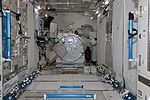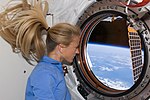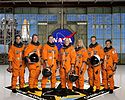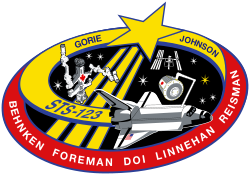STS-124
| STS-124 | |||||
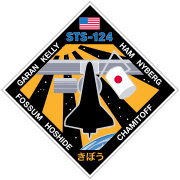 | |||||
| Uppdrag | 123 | ||||
|---|---|---|---|---|---|
| Rymdfärja | Discovery (35) | ||||
| NSSDC-ID | 2008-027A[1] | ||||
| Färdens tid | 13 dagar, 18 timmar, 13 minuter, 7 sekunder | ||||
| Uppskjutning | |||||
| Startplats | Startplatta 39A vid Kennedy Space Center i Florida | ||||
| Start | 31 maj 2008 23.02 CEST | ||||
| Landning | |||||
| Landningsplats | KSC runway 15 | ||||
| Landning | 14 juni 2008 17.15 CEST | ||||
| Omloppsbana | |||||
| Varv | 217 st[2] | ||||
| Apogeum | 314 km | ||||
| Perigeum | 231 km | ||||
| Banlutning | 51,6° | ||||
| Sträcka | 9,2 miljoner km | ||||
| Rymdpromenad | |||||
| Antal | 3 st | ||||
| Total tid | 20 timmar, 32 minuter | ||||
| Dockning | |||||
| Rymdstation | ISS | ||||
| Dockning | 2 juni 2008, 18:03 UTC | ||||
| Dockningsport | PMA-2 (Harmony, fram) | ||||
| Urdockning | 11 juni 2008, 11:42 UTC | ||||
| Tid dockad | 8 dagar, 17 timmar, 39 minuter | ||||
| Besättning | |||||
| Befälhavare | Mark E. Kelly (3) | ||||
| Pilot | Kenneth Ham (1) | ||||
| Uppdragsspecialister | Karen L. Nyberg (1) Ronald J. Garan, Jr. (1) Michael E. Fossum (2) Akihiko Hoshide (1) | ||||
 | |||||
| Kronologi Rymdfärjeprogrammet | |||||
| |||||
STS-124 var en rymdfärd till den Internationella rymdstationen ISS, som genomfördes av den amerikanska rymdfärjan Discovery mellan den 31 maj 2008 och den 14 juni 2008.
Uppdragets mål
Discovery levererade och installerade laboratoriet PM (Pressurized Module) samt robotarmana (JEM RMS) till det japanska laboratoriet Kibō, samt flyttade den tidigare uppskjutna japanska lagermodulen ELM-PS till sin permanenta plats ovanpå PM. Discovery levererade även annan utrustning, bland annat av ISS besättning efterlängtade reservdelar till en toalett.
Aktiviteter
Innan uppskjutning
Discovery rullade över till Vehicle Assembly Building från sin hangar den 26 april där hon förbereddes för start. Den 3 maj rullade Discovery ut till startplatta 39A.
Aktiviteter dag för dag

Dag 1: Lyckad start klockan 23.02 svensk sommartid från Kennedy Space Center. Små bitar av isolering lossnade från den externa bränsletanken men var ingen risk för Discovery. Däremot skadades startplattan så svårt att reparationer var nödvändiga innan påföljande start. När Discovery nått sin omloppsbana öppnades lastrums-dörrarna, antennen fälldes ut och robotarmen aktiverades.
Dag 2: Man kunde endast genomföra begränsad inspektion efter start bland annat av vingkanter och värmeskyddsplattor på grund av Kibō. Förberedelser inför dockningen med ISS gjordes.
Dag 3: När Discovery var strax under rymdstationen manövrerades hon i en bakåtvolt så ISS-besättningen kunde ta bilder på hennes undersida, varefter hon dockade med ISS klockan 20.03 svensk sommartid.
Dag 4: Fossum och Garan utförde den första rymdpromenaden, se avsnitt EVA 1 nedan. Det nya laboratoriet PM lyftes med hjälp av Canadarm2 ur Discoverys lastrum och placerades på sin plats på Harmonys babord port.
Dag 5: Luckan till den nya Kibō modulen öppnades. Besättningen lagade även den trasiga toaletten.
Dag 6: Fossum och Garan utförde den andra rymdpromenaden, se avsnitt EVA 2 nedan.
Dag 7: Intervjuer med media samt att Kibōs förrådsmodul flyttades från sin tillfälliga plats på Harmony till sin permanenta på Kibō.
Dag 8: Kibōs robotarm manövrerades för första gången med Hoshide och Nyberg vid kontrollerna.
Dag 9: Fossum och Garan utförde den tredje rymdpromenaden, se avsnitt EVA 3 nedan.
Dag 10: Fortsatta tester av den japanska robotarmen genomfördes, samt konferens med massmedia.
Dag 11: Luckan mellan ISS och Discovery stängdes 21.49 svensk tid.
Dag 12: Discovery separerade från ISS klockan 13.42 svensk tid. Sedan följde den traditionella flygningen runt ISS och därefter slutfördes kontrollerna från dag 2.
Dag 13: En mestadels ledig dag för besättningen. Pilot Kenneth Ham intervjuades i ett radioprogram.
Dag 14: Besättningen förberedde Discovery inför landningen.
Dag 15: Discovery landade lyckat på bana 15 på Kennedy Space Center den 14 juni. Discovery avslutade därmed STS-124 och sitt 35:e uppdrag efter 217 varv runt jorden.
Rymdpromenader
EVA 1
Astronauterna flyttade Orbiter Boom Sensor System som lämnades av föregående uppdrag från styrbord truss till rymdfärjan. Sedan förberedde man Kibō PM inför anslutningen till ISS samt utförde service och inspektion av rotationsmekanismen för solpanelerna på styrbord truss. Fossum och Garan utförde rymdpromenaden som varade i sex timmar och fyrtioåtta minuter.
EVA 2
Astronauterna installerade extern utrustning på Kibō samt förberedde lagermodulen ELM-PS inför dess flytt nästa dag. Sedan förbereddes ett byte av en kvävetank på truss och till sist monterades en kamera bort som hade tappat sin kraftförsörjning. Fossum och Garan utförde även denna rymdpromenad som varade i sju timmar och elva minuter.
EVA 3
Fossum och Garan slutförde bytet av kvävetanken och monterade en ny TV-kamera i stället för den som togs bort under EVA 2. Installationen av extern utrustning på Kibō slutfördes. Rymdpromenaden varade i sex timmar och trettiotre minuter.
Besättning
 USA Mark E. Kelly, befälhavare. (3).
USA Mark E. Kelly, befälhavare. (3). USA Kenneth Ham, pilot. (1).
USA Kenneth Ham, pilot. (1). USA Karen L. Nyberg, uppdragsspecialist. (1).
USA Karen L. Nyberg, uppdragsspecialist. (1). USA Ronald J. Garan, Jr., uppdragsspecialist. (1).
USA Ronald J. Garan, Jr., uppdragsspecialist. (1). USA Michael E. Fossum, uppdragsspecialist. (2).
USA Michael E. Fossum, uppdragsspecialist. (2). Japan Akihiko Hoshide, uppdragsspecialist. (1)
Japan Akihiko Hoshide, uppdragsspecialist. (1)
Siffran inom parentes visar antal rymdfärder inklusive denna som personen gjort.
Besättning på ISS som byttes med detta uppdrag
 USA Gregory Chamitoff, uppdragsspecialist. Reste med Discovery för att ingå i Expedition 17 på ISS
USA Gregory Chamitoff, uppdragsspecialist. Reste med Discovery för att ingå i Expedition 17 på ISS USA Garrett Reisman, uppdragsspecialist. Återvände till jorden från Expedition 17. (1).
USA Garrett Reisman, uppdragsspecialist. Återvände till jorden från Expedition 17. (1).
Galleri
- Video som visar starten
- Fossum under EVA 2 den 5 juni 2008.
- Bild tagen inuti Kibo den 7 juni 2008.
- Karen Nyberg tittar ut genom ett fönster på Kibo den 10 juni 2008.
- ISS efter STS-124 den 11 juni 2008.
- Discovery landar den 14 juni 2008.
Väckningar
Under Geminiprogrammet började NASA spela musik för besättningar och sedan Apollo 15 har man varje "morgon" väckt besättningen med ett särskilt musikstycke, särskilt utvalt antingen för en enskild astronaut eller för de förhållanden som råder.
| Dag | Låt | Artist/Kompositör | Spelad för | Länk |
|---|---|---|---|---|
| 2 | Your Wildest Dreams | the Moody Blues | Kenneth Ham | wav mp3 |
| 3 | Away from Home | José Molina Serrano | Greg Chamitoff | wav mp3 |
| 4 | Hold Me with the Robot Arm | Yusuke Hanawa | Akihiko Hoshide | wav mp3 |
| 5 | Have You Ever | Brandi Carlile | Karen Nyberg | wav mp3 |
| 6 | Fly Away | Lenny Kravitz | Ron Garan | wav mp3 |
| 7 | Bright as Yellow | Innocence Mission | Karen Nyberg | wav mp3 |
| 8 | Taking Off | Godaigo | Akihiko Hoshide | wav mp3 |
| 9 | The Mickey Mouse Club March | wav mp3 | ||
| 10 | The Spirit of Aggieland | the Fightin’ Texas Aggie Band | Mike Fossum | wav mp3 |
| 11 | All Because of You | U2 | Ron Garan | wav mp3 |
| 12 | Centerfield | John Fogerty | Kenneth Ham | wav mp3 |
| 13 | Crystal Frontier | Calexico | Mark E. Kelly | wav mp3 |
| 14 | Baby, Won't You Please Come Home | Louis Prima och Keely Smith | Garrett Reisman | wav mp3 |
| 15 | Life on an Ocean Wave | the US Merchant Marine Academy Band | Mark Kelly | wav mp3 |
Se även
Källor
- [1] NASA:s STS-124 presskit läst 13 september 2009
- NASAs sida om STS-124
- Svensk sida om STS-124
Referenser
- ^ ”NASA Space Science Data Coordinated Archive” (på engelska). NASA. https://nssdc.gsfc.nasa.gov/nmc/spacecraft/display.action?id=2008-027A. Läst 22 mars 2020.
- ^ Manned Astronautics - Figures & Facts Arkiverad 5 oktober 2015 hämtat från the Wayback Machine., läst 28 juli 2016.
Externa länkar
 Wikimedia Commons har media som rör STS-124.
Wikimedia Commons har media som rör STS-124.
| ||||||||
| |||||||||||||||||||||||||||||||
| ||||||||||||||||||||||||||||||||
Media som används på denna webbplats
Astronaut Karen Nyberg, STS-124 mission specialist, looks through a window in the newly installed Kibo laboratory of the International Space Station while Space Shuttle Discovery is docked with the station.
One of an ongoing series of digital still images documenting the Japanese Experiment Module, or JEM, also called Kibo, in its new home on the International Space Station, this view depicts Kibo's interior.
Backdropped by a blue and white part of Earth, the International Space Station is seen from Space Shuttle Discovery as the two spacecraft begin their relative separation. Earlier the STS-124 and Expedition 17 crews concluded almost nine days of cooperative work onboard the shuttle and station. Undocking of the two spacecraft occurred at 6:42 a.m. (CDT) on June 11, 2008.
In this illustration, a SpaceX Crew Dragon spacecraft approaches the International Space Station for docking. NASA is partnering with Boeing and SpaceX to build a new generation of human-rated spacecraft capable of taking astronauts to the station and expanding research opportunities in orbit. SpaceX's upcoming Demo-1 flight test is part of NASA’s Commercial Crew Transportation Capability contract with the goal of returning human spaceflight launch capabilities to the United States.
en:Space Shuttle Discovery launches on mission en:STS-124 to the en:International Space Station, from en:Kennedy Space Center, 31 May en:2008
Space Shuttle Discovery's drag chute is deployed as the spacecraft rolls toward wheels stop on runway 15 of the Shuttle Landing Facility at NASA's Kennedy Space Center, concluding the 14-day STS-124 mission to the International Space Station. Onboard are NASA astronauts Mark Kelly, commander; Ken Ham, pilot; Mike Fossum, Ron Garan, Karen Nyberg, Garrett Reisman and Japan Aerospace Exploration Agency astronaut Akihiko Hoshide, all mission specialists. The main landing gear touched down at 11:15:19 a.m. (EDT) on June 14, 2008. The nose landing gear touched down at 11:15:30 a.m. and wheel stop was at 11:16:19 a.m. During the mission, Discovery's crew installed the Japan Aerospace Exploration Agency's large Kibo laboratory and its remote manipulator system leaving a larger space station and one with increased science capabilities.
Författare/Upphovsman: Pascal (Flickr user: pasukaru76), Licens: CC0
Vostok spacecraft replica at the Technik Museum Speyer, Germany.
Backdropped by a blue and white Earth, this close-up view features the Soyuz TMA-6 spacecraft approaching the International Space Station (ISS). Onboard the spacecraft are cosmonaut Sergei K. Krikalev, Expedition 11 commander representing Russia's Federal Space Agency; astronaut John L. Phillips, NASA ISS science officer and flight engineer; and European Space Agency (ESA) astronaut Roberto Vittori of Italy. The Soyuz linked to the Pirs Docking Compartment at 9:20 p.m. (CDT) on April 16, 2005 as the two spacecraft flew over eastern Asia. The docking followed Friday’s launch from the Baikonur Cosmodrome in Kazakhstan.
Official crew portrait image of STS-124 space shuttle crew; From the left are astronauts Gregory E. Chamitoff, Michael E. Fossum, both STS-124 mission specialists; Kenneth T. Ham, pilot; Mark E. Kelly, commander; Karen L. Nyberg, Ronald J. Garan and Japan Aerospace Exploration Agency's (JAXA) Akihiko Hoshide, all mission specialists. Chamitoff is scheduled to join Expedition 17 as flight engineer after launching to the International Space Station on mission STS-124. The crewmembers are attired in training versions of their shuttle launch and entry suits.
Astronaut Mike Fossum, STS-124 mission specialist, participates in the mission's second scheduled session of extravehicular activity (EVA) as construction and maintenance continue on the International Space Station. During the seven-hour, 11-minute spacewalk, Fossum and astronaut Ron Garan (out of frame), mission specialist, installed television cameras on the front and rear of the Kibo Japanese Pressurized Module (JPM) to assist Kibo robotic arm operations, removed thermal covers from the Kibo robotic arm, prepared an upper JPM docking port for flight day seven's attachment of the Kibo logistics module, readied a spare nitrogen tank assembly for its installation during the third spacewalk, retrieved a failed television camera from the Port 1 truss, and inspected the port Solar Alpha Rotary Joint (SARJ).
The STS-126 patch represents Space Shuttle Endeavour on its mission to help complete the assembly of the International Space Station (ISS). The inner patch outline depicts the Multi-Purpose Logistics Module (MPLM) Leonardo. This reusable logistics module will carry the equipment necessary to sustain a crew of six on board the ISS and will include additional crew quarters, exercise equipment, galley, and life support equipment. In addition, a single expedition crew member will launch on STS-126 to remain on board ISS, replacing an expedition crew member who will return home with the shuttle crew. Near the center of the patch, the constellation Orion reflects the goals of the human spaceflight program, returning us to the Moon and on to Mars, the red planet, which are also shown. At the top of the patch is the gold symbol of the astronaut office. The sunburst, just clearing the horizon of the magnificent Earth, powers all these efforts through the solar arrays of the ISS current configuration orbiting high above.
Emblem of Nasa's STS-124 mission.
- The STS-124/1J patch depicts the Space Shuttle Discovery docked with the International Space Station (ISS). STS-124/1J is dedicated to delivering and installing the Japanese Experiment Module (JEM) known as Kibo (Hope) to the ISS. The significance of the mission and the Japanese contribution to the ISS is recognized by the Japanese flag depicted on the JEM Pressurized Module (JPM) and the word Kibo written in Japanese at the bottom of the patch. The view of the sun shining down upon the Earth represents the increased "hope" that the entire world will benefit from the JEM's scientific discoveries. The JPM will be the largest habitable module on the ISS and is equipped with its own airlock and robotic arm for external experiments. In addition to delivering and installing the JPM, the STS-124 crew will relocate the JEM Logistics Pressurized (JLP) module to its permanent home on the zenith side of the JPM. During three planned space walks, the crew will perform external ISS maintenance and JPM outfitting, as well as extensive robotic operations by the ISS, space shuttle, and JEM robotic arms. It will be the first time that three different robotic arms will be operated during a single space flight mission.
Master Tape #734048 -- 01:13:25-01:14:31 -- Space shuttle Discovery launches to the International Space Station on Saturday, May 31, 2008.
Rotated and color enhanced version of original (ISS013-E-48788 (6 July 2006) --- The Space Shuttle Discovery approaches the International Space Station for docking but before the link-up occurred, the orbiter went through a series of inspection photos by station crew to inspect the vehicle for any damage to its Thermal Protection System. This was known as the Rendezvous Pitch Maneuver and was implemented after the Columbia Disaster in 2003. The Leonardo Multipurpose Logistics Module can be seen in the shuttle's cargo bay. Discovery docked at the station's Pressurized Mating Adapter 2 at 9:52 a.m. CDT, July 6, 2006.)
STS-123 continues assembly of the International Space Station (ISS). The primary mission objectives include rotating an expedition crew member and installing both the first component of the Japanese Experimental Module (the Experimental Logistics Module - Pressurized Section (ELM-PS)) and the Canadian Special Purpose Dexterous Manipulator (SPDM). In addition, STS-123 will deliver various spare ISS components and leave behind the sensor boom used for inspecting the shuttle's thermal protection system. A follow-on mission to ISS will utilize and then return home with this sensor boom. A total of five spacewalks are planned to accomplish these tasks. The mission will also require the use of both the shuttle and ISS robotic arms. STS-123 will utilize the Station-Shuttle Power Transfer System to extend the docked portion of the mission to eleven days, with a total planned duration of 15 days. The crew patch depicts the space shuttle in orbit with the crew names trailing behind. STS-123's major additions to ISS (the ELM-PS installation with the shuttle robotic arm and the fully constructed SPDM) are both illustrated. The ISS is shown in the configuration that the STS-123 crew will encounter when they arrive.

